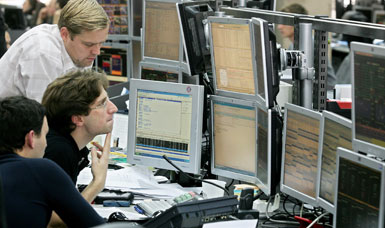NEW YORK - When the emir of Qatar, the leader of one of the world's richest countries, was asked about the security of his investments, Sheik Hamad bin Khalifa al-Thani remarked: "The day our oil and gas will finish, we will not go back to our camels."
The emir was apparently confident his country was making the right investments to ensure its long-term economic stability when finite resources, including oil and natural gas, may run out in the next few decades.
With oil prices skyrocketing in the world market, some of the Middle Eastern nations such as Qatar, Kuwait, Saudi Arabia and the United Arab Emirates have been investing their monies not only in volatile capital markets in the US and Western Europe but also in education and human development within their own shores.
 |
| Traders look at monitors during a trading session at Alfa Bank in Moscow on Friday. AFP |
Still, some of these countries, blessed with oil riches and possessing an abundance of natural gas reserves, could be jolted by the financial turmoil that has engulfed the US and likely to spread to Western Europe.
With the dramatic collapse of American financial institutions last week and the sharp decline in the stock market, there are fears the negative fallout may spill over into institutions in the Middle East and Asia, including countries such as China, Japan, South Korea, India and Singapore.
A country that lives by the concept of free enterprise and a textbook market economy, the US has been forced to intervene to prevent the financial crisis from spreading across the world.
As the New York Times rightly pointed out, Wall Street has traditionally been governed by two factors: greed and fear. But last week fear overshadowed greed as thousands of high paying staffers in investment banks were out of jobs due to close-outs, mergers and bankruptcies.
The Bush administration is expected to approve a proposal by the Federal Reserve Bank for a vast bailout plan-- running into hundreds of billions of dollars-- to rescue more investment banks from collapsing. "What we are working on now is an approach to deal with systemic risks and stresses in our capital markets," Henry Paulson Jr., the US Treasury Secretary, was quoted as saying on Friday.
Having made some erratic investments during the oil price boom of the 1970s, some of the Middle Eastern nations have continued to diversify their portfolios to protect themselves from fluctuating markets.
Last year the Abu Dhabi Media Company struck a $1 billion deal with Hollywood's Warner Brothers to make movies and video games. The ruler of Abu Dhabi, Sheik Mansur bin Zayed al-Nahyan, has purchased Manchester City, an English soccer club, once owned by the exiled Prime Minister of Thailand, Thakshin Shinawatra.
But some of the biggest investments of some of these newly-affluent countries have been in sovereign wealth funds at home. China alone has increased its foreign reserve holdings from 0.1 to $1.7 trillion between 1999 through end of March this year, according to the latest figures released by the United Nations.
Among developing nations, India has been ranked number three with $300 billion in reserves, just below two industrialised nations: Japan at $993 billion, and Russia at $493 billion. India is still ahead of South Korea, designated an industrial nation, with reserves amounting to $264 billion.
As of last year, some of the countries with the largest sovereign wealth funds (SWFs), mostly in oil and energy rich nations, include: the United Arab Emirates ($875 billion); Norway ($341 billion); Singapore ($330 billion); Saudi Arabia ($300 billion); Kuwait ($250 billion); and China ($200 billion dollars).
SWFs are defined by Forbes magazine as "pools of money derived from a country's reserves, which are set aside for investment purposes that will benefit the country's economy and citizens."
The reserves and SWFs have one thing in common: they are all state-owned, in contrast to foreign direct investments (FDI), which are both public and private. The SWF assets of developing countries are estimated at around $3.0 trillion.
The largest of the SWFs is the Abu Dhabi Investment Authority, maintained by the United Arab Emirates. Other major SWFs include the Qatar Investment Authority and China's State Administration of Foreign Exchange (SAFE).
"This has given developing countries a greater buffer or 'self-insurance' to cope with external shocks," says the "World Economic and Social Survey 2008", released by the UN.
According to the survey, a level of reserves covering about three months of imports was long considered adequate. But one of the lessons drawn from the July 1997 Asian financial crises was that developing nations should also have adequate reserves to cover their short-term external debt.
"At present, however, developing countries have been accumulating reserves well in excess of that more recent standard," the study says.
In a political twist to the story, the Wall Street Journal recently quoted a report from the McKinsey Global Institute which said some of the mountains of petrodollars are also likely to be used "to advance anti-American political agendas".
According to the McKinsey report, "The rise of a broader range of countries with SWFs heightens concerns about the potential non-economic motives and political ramifications of their investments." And Venezuela's President Hugo Chavez is accused of "financing his Western hemisphere crusade against American influence with petrodollars."
| 
